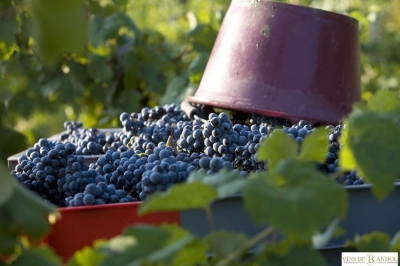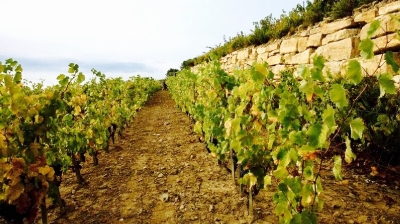Bandol is a small coastal Provencal appellation, nestled between the port cities of Marseille and Toulon. Its picturesque vineyards cover the slopes of a large, natural amphitheatre descending on the sea from three sides, dotted with olive trees and oak forests. Despite its small size (under 1,500 hectares today), it has an enviable international reputation, both for its reds (20% of production) and for its rosés (75%).
For much of its history, it has been seen as distinct and quite separate from the rest of Provence, not least for the preponderance of the Mourvèdre grape variety, required to be at least 60% of the reds and 20% of the rosés. Mourvèdre is a beautiful grape variety, dark and tannic, creating long-lived wine – especially when aged for long periods in oak, as is mandated for Bandol’s reds (18 months in foudres).
Mourvèdre’s dominance is however relatively new. Legend has it that it was brought back from Spain via the pilgrim route to Santiago de Compostela. Known as Monastrell in Spain, it took on various names as it progressed eastwards, known as the plante de St Gilles, in the coastal region of the Costieres de Nimes. By the time the appellation was created in 1941, it was Mourvèdre which marked the distinction between the ordinary quaffing wine and the premium wines of the wealthy estate owners. The Peyraud-Tempier family of Domaine Tempier collected cuttings from their friends at Chateau Beaucastel in Châteauneuf-du-Pape.
Once established on the clay and alkaline limestone slopes of Bandol, Mourvèdre revealed its star quality. Over the years producers have identified the micro-terroirs which give rise to subtle differences between more limestone (fresh elegance) or more clay (more robust fruit), resulting in a growing number of single-vineyard wines. The coastal sites of neighbouring Côtes de Provence La Londe do produce some age worthy Mourvèdre, but rarely with the rich power of Bandol, the more acidic degraded schist soils of La Londe seeming to produce, in my experience, more mineral, leaner structured wines.
The sunny exposure of the south facing dry-stone-walled terraced slopes gives Mourvèdre the chance to fulfil its potential. The most famous local saying proudly confirming that what makes Bandol reds great, is that Mourvèdre needs to have la tête au soleil et les pieds dans l’eau, or its head in the sun and its feet in water. Domaine Terrebrune lies close to the sea, while the vines of Domaine de la Bégude look down over the sea from the highest slopes at 400m. Cooler sites, influenced by the infamous Mistral winds, can result in fresher wines. As a famously sun-thirsty late-ripener, that, in Provence, seems to thrive best in coastal regions, although climate change is making an impact. Jean-Francois Ott, for example, has introduced Mourvèdre into his inland Provence estates.
It is also felt to go through the ages of man – a difficult, sometimes stinky reductive baby, that opens up after a few years, before subsequently closing up again, becoming a ‘moody teenager’, that is only drinkable after a further decade of bottle-ageing. Well-made Bandol can go back 20 years without noticeably losing any fruit, acidity or even softening its tannins. Back in the ‘80s, extended maceration required mellow ageing, meaning you didn’t even touch it for the first fifteen years for fear of its ferocious tannic grip.
The use of oak varies, with the larger estates benefitting from their greater capacity to use large foudres (1000+l), while others use demi-muids (600l) and barriques (225l). New and old oak, different origins and toast further contribute to the nature of the tannins. Some producers embrace Bandol’s oaky age-worthiness, and let a little more oak shine in the wines. Good examples include Château Vannières, Domaine de la Font des Peres and Pibarnon – the latter of which part-ages in more neutral Austrian oak.
Some producers eschew oak, preferring to declassify to Vin de France or IGP Med and age their wines in eggs or amphora, allowing Mourvèdre’s black fruit and charm to shine even when youthful. Good examples include Bégude’s Thyrsus, Domaine de la Bastide Blanche’s Contrechamps red (the rosé, however, is aged in oak) and Tour du Bon’s En Sol – a 100% Mourvèdre fermented and aged in large jarres.
Despite its traditional image, Bandol has a natural wine scene, with several exceptional producers making good, age-worthy wines within the AOP. Domaine Castell-Reynoard stands out for its pragmatic approach to polyculture, with tomato plants dotted between the grapevines, and Château Sainte-Anne, an early adopter of low-intervention winemaking was my first love a few decades ago, when I was first entranced by the power and fruit of aged Bandol.
Mourvèdre is complemented by Grenache Noir, Cinsault or Carignan, although many producers aim for 95% Mourvèdre for their top, most age-worthy cuvées. Grenache, prone to oxidation, is felt to balance Mourvèdre’s reductivity – it is famously thirsty for oxygen during fermentation, while the Carignan and Cinsault contribute freshness. Few producers drop Mourvèdre (and the AOP) entirely, Font des Pères’ La Reppe, a 100% Carignan in an equally well-made and age-worthy style, being a rare exception.
With over 60 producers, of which only a third are sizable estates with commercial volumes, and many estates being small with only a few hectares, it is safe to say that there is plenty of diversity in style, and plenty of discussion over the way the appellation is evolving. Fresh drinking reds and rosés may please the banks, but it is the glorious age worthy reds which capture producers and wine drinkers’ hearts and which are inspiring their Provence neighbours to emulate their style.
Tasting Notes
Val d’Arenc 2015
Old vine Mourvèdre from the heartland of this estate, from the Arenc lieu-dt, this wine includes some ageing in a concrete egg and is only made in small quantities. Delicate powdery blue perfume on the nose opening out to a wine with remarkable youthfulness despite its age. Fresh crunchy redcurrant fruit, a hint of hedgerow florals, wild berry pippy textured tannins, long vibrant acidity kept on a tight leash by careful use of oak leading to a saline finish. Zesty, fresh, elegant, with a pleasing linear length.
Domaine Maubernard 2015
Intense wild strawberries on the nose which continue onto the palate along with rich strawberry and sour cherry jam notes and the darker notes of cacao, dark chocolate, roasting coffee and spicy apple crumble fresh from the oven as the toast and smoke from the oak emerges after the fruit. Firm, grippy, textured tannins, full of muscle and power and mouth clenching long fresh acidity and saline finish complete this expression of gorgeous youthful power. The ultimate moody Marlon Brando!
Château Sainte Anne Collection 2016
From one of a handful of more natural producers comes this more traditional style. Aromas of smoky strawberries develop into more opulent wild strawberry fruit, perfumed blue flowers, wild fennel and sweet tarragon notes and a touch of spice, held together by firm, grippy, textural almost mouth-wrenching tannins. The fresh acidity leads to a saline mineral finish. Still very youthful with potential to age.
Domaine Dupuy de Lome Cuvée des Grès 2017
Black tea, cooked black fruit, and a hint of sweet rosemary and lavender garrigue aromas. On the palate, firm, well-integrated, delicately grainy tannins accompanied by lively acidity and fresh, juicy cranberries, sweet ripe cherries and raspberries, as well as some darker elderberries. Warm spice, tobacco and black pepper lead into a saline mineral finish. Beautiful fresh elegance and a full-bodied opulent ripeness to remind you you’re in the south of France.
Famille Ott Chateau Romassan 2018
Hints of morello cherries, black tea and smoky Lapsang Souchong aromas lead into smooth concentrated fruit of opulent cherries, ripe red currants, fresh raspberries and a touch of sweet figs lurking behind a closed, taciturn moodiness. The oak has the sweetness of salty liquorice, the tannins start off subtly building up to structured velvet, the acidity is hauntingly elegant and mouthwatering. Concentrated, dark, inky minerality, with a long lasting finish.
Domaine Pieracci 2018
Black fruit and toast aromas with hints of scented potpourri opening out to some surprisingly vibrant red fruit. Wild raspberries, redcurrants, fresh sour red berries and elegantly juicy acidity. The toasty notes merge into some darker saline minerality while the ripe fruit gives a creamy roundness and the tannins have an intriguing grainy texture. Elegant and classy, this wine still has hidden power while being eminently drinkable now.
Domaine de la Bégude 2019
Delicate aromas of smokey lavender reveal little of the complexity hiding in the glass. The perfume continues on the palate with an inky freshness behind the ripe red fruit, wild strawberries, jammy mulberries and a hint of raspberries lifted by the sourness of cranberry juice acidity and slightly pippy tannins. The concentrated fruit lifts to reveal layers of oaky spice and inky black tannins and elegant acidity, erring on the side of austerity and freshness with youthful edginess.
Lafran Veyrolles Les Hauts de Lafran 2020
Creamy red fruit, parma violets and smoky oak on the nose moving on to youthful soft supple red fruit, crunchy hedgerow berries, some perfumed florals and smoky oak. This is a youthful monster, and the kind of Bandol that you keep for twenty years, or at least decant if you want to drink now. Firm, austere minerality, long vibrant acidity and firm grippy tannins dominate but the ripe fruit and elegant florals peek through as it opens up promising so much more with age.
Chateau Pibarnon 2020
Smoke and the resinous notes of garrigue on the nose. On the palate the wine is bold and confident. Opulent dark black velvet texture with dark sour salty plum umami notes, black forest gateau with lots of dark chocolate and vibrant cherries, sour wild berries and sloe plum acidity, firm grippy tannins from beautifully integrated oak and finishing with notes of garrigue, nuts and leather balancing the richness. Beautiful depth and elegance with intriguing juxtaposition of richness and restraint, sweet and sour complexity with potential for long ageing.
Elizabeth Gabay MW grew up a Londoner but always travelled around Europe with her family. After back-packing around the world, Elizabeth returned to London where, by accident she fell into the wine trade when her parents bought a holiday cottage in Provence. Elizabeth passed the Master of Wine exam in 1998, and, in 2002, moved to a village an hour north of Nice. Her thirty years of working in Provence led in 2018 to her first book Rosé, Understanding the Pink Wine Revolution. With her son Ben Bernheim, they have put together an on-line Buyers Guide to the Rosés of Southern France, published in 2021. A new guide on the Rosés of Southern France, focusing on regional differences and old vintages was published in 2022. Elizabeth recently released a natural rosé called Sen (Dream) made with Slovakian producer Vladimir Magula.


